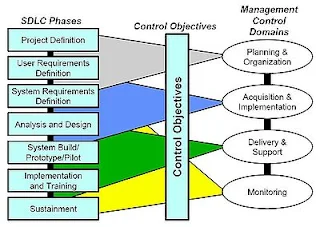The Systems Development Life Cycle (SDLC), or Software Development Life Cycle in systems engineering, information systems and software engineering, is the process of creating or altering systems, and the models and methodologies that people use to develop these systems. The concept generally refers to computer or information systems.
In software engineering the SDLC concept underpins many kinds of software development methodologies. These methodologies form the framework for planning and controlling the creation of an information system
Systems and Development Life Cycle (SDLC) is a process of process used by a systems analyst to develop an information system, including requirements, validation, training, and user (stakeholder) ownership. Any SDLC should result in a high quality system that meets or exceeds customer expectations, reaches completion within time and cost estimates, works effectively and efficiently in the current and planned Information Technology infrastructure, and is inexpensive to maintain and cost-effective to enhance.
Requirements gathering and analysis
The goal of system analysis is to determine where the problem is in an attempt to fix the system. This step involves breaking down the system in different pieces to analyze the situation, analyzing project goals, breaking down what needs to be created and attempting to engage users so that definite requirements can be defined. Requirements analysis sometimes requires individuals/teams from client as well as service provider sides to get detailed and accurate requirements....often there has to be a lot of communication to and from to understand these requirements. Requirement gathering is the most crucial aspect as many times communication gaps arise in this phase and this leads to validation errors and bugs in the software program.
Design
In systems, design functions and operations are described in detail, including screen layouts, business rules, process diagrams and other documentation. The output of this stage will describe the new system as a collection of modules or subsystems.
The design stage takes as its initial input the requirements identified in the approved requirements document. For each requirement, a set of one or more design elements will be produced as a result of interviews, workshops, and/or prototype efforts. Design elements describe the desired software features in detail, and generally include functional hierarchy diagrams, screen layout diagrams, tables of business rules, business process diagrams, pseudocode, and a complete entity-relationship diagram with a full data dictionary. These design elements are intended to describe the software in sufficient detail that skilled programmers may develop the software with minimal additional input design.
Build or coding
Modular and subsystem programming code will be accomplished during this stage. Unit testing and module testing are done in this stage by the developers. This stage is intermingled with the next in that individual modules will need testing before integration to the main project.
Testing
The code is tested at various levels in software testing. Unit, system and user acceptance testings are often performed. This is a grey area as many different opinions exist as to what the stages of testing are and how much if any iteration occurs. Iteration is not generally part of the waterfall model, but usually some occur at this stage.
Below are the following types of testing:
Data set testing.
Unit testing
System testing
Integration testing
Black box testing
White box testing
Regression testing
Automation testing
User acceptance testing
Performance testing
Production
definition:- it is a process that ensures that the program performs the intended task.
Operations and maintenance
The deployment of the system includes changes and enhancements before the decommissioning or sunset of the system. Maintaining the system is an important aspect of SDLC. As key personnel change positions in the organization, new changes will be implemented, which will require system updates.
This Blog helps you to define your all problems regarding Computer Sc. Info Technology and Management. In this Blog you'll get your topic, solution for your questions as well as you get knowledge about new technologies and Corporate world updates also. Here you'll also get new ideas, techniques, various useful websites links and many more. Please also suggest me, what more i do for this Blog and for its enhancements. WELCOME suggestions & queries at amitesh_km@hotmail.com
Subscribe to:
Post Comments (Atom)


Very helpful note 4 bca persuing student.
ReplyDeleteArcadian mku batch 3.1
ReplyDeleteWonderful blog & good post.Its really helpful for me, awaiting for more new post. Keep Blogging!
ISTQB Training Institute in Chennai